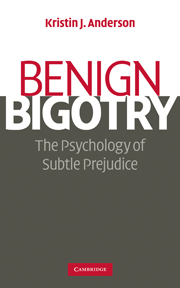Book contents
- Frontmatter
- Contents
- Acknowledgments
- Introduction: The changing place of prejudice: a migration underground
- 1 “Those people all look alike”: The myth of the other
- 2 “They must be guilty of something”: Myths of criminalization
- 3 “Feminists are man-haters”: Backlash myth-making
- 4 “Gays flaunt their sexuality”: The myth of hypersexuality
- 5 “I'm not a racist, I'm colorblind”: The myth of neutrality
- 6 “Affirmative action is reverse racism”: The myth of merit
- Conclusion
- Index
Conclusion
Published online by Cambridge University Press: 05 June 2012
- Frontmatter
- Contents
- Acknowledgments
- Introduction: The changing place of prejudice: a migration underground
- 1 “Those people all look alike”: The myth of the other
- 2 “They must be guilty of something”: Myths of criminalization
- 3 “Feminists are man-haters”: Backlash myth-making
- 4 “Gays flaunt their sexuality”: The myth of hypersexuality
- 5 “I'm not a racist, I'm colorblind”: The myth of neutrality
- 6 “Affirmative action is reverse racism”: The myth of merit
- Conclusion
- Index
Summary
We have come to the end of a journey – a journey that has allowed us to explore the world beneath the surfaces we see in our everyday interactions. The analysis in this book has framed some ordinary, often unconscious, “common-sense” assumptions as myths rather than as pieces of wisdom whose correctness is self-evident. Although it appears that we can make sense of the world around us by applying common sense, what travels socially as “common sense” is, in many instances, nothing more than misguided assumptions – a combination of underlying misinformation, repetitions of traditional biases, and prejudices. These shared, unexplored assumptions about the world come from the status quo (and its attendant distribution of power). These assumptions have the effect of explaining our world and justifying its organization in terms of race, ethnicity, gender, and sexuality systems of social inequality. These assumptions produce the very myths we have explored in this book. These myths feel harmless to many people if they believe they are based on truths, rather than reflecting biases and bigotry.
The apparent fact that members of “minorities” seem to share some of these beliefs does not constitute assent or agreement, nor does it make these myths any more true. As Beverly Daniel Tatum says, we all breathe the smog of racism. On the contrary, what appears to be consent is an illustration of the pervasiveness and effectiveness of mystification and myth-making in the service of systems of power.
- Type
- Chapter
- Information
- Benign BigotryThe Psychology of Subtle Prejudice, pp. 335 - 348Publisher: Cambridge University PressPrint publication year: 2009

